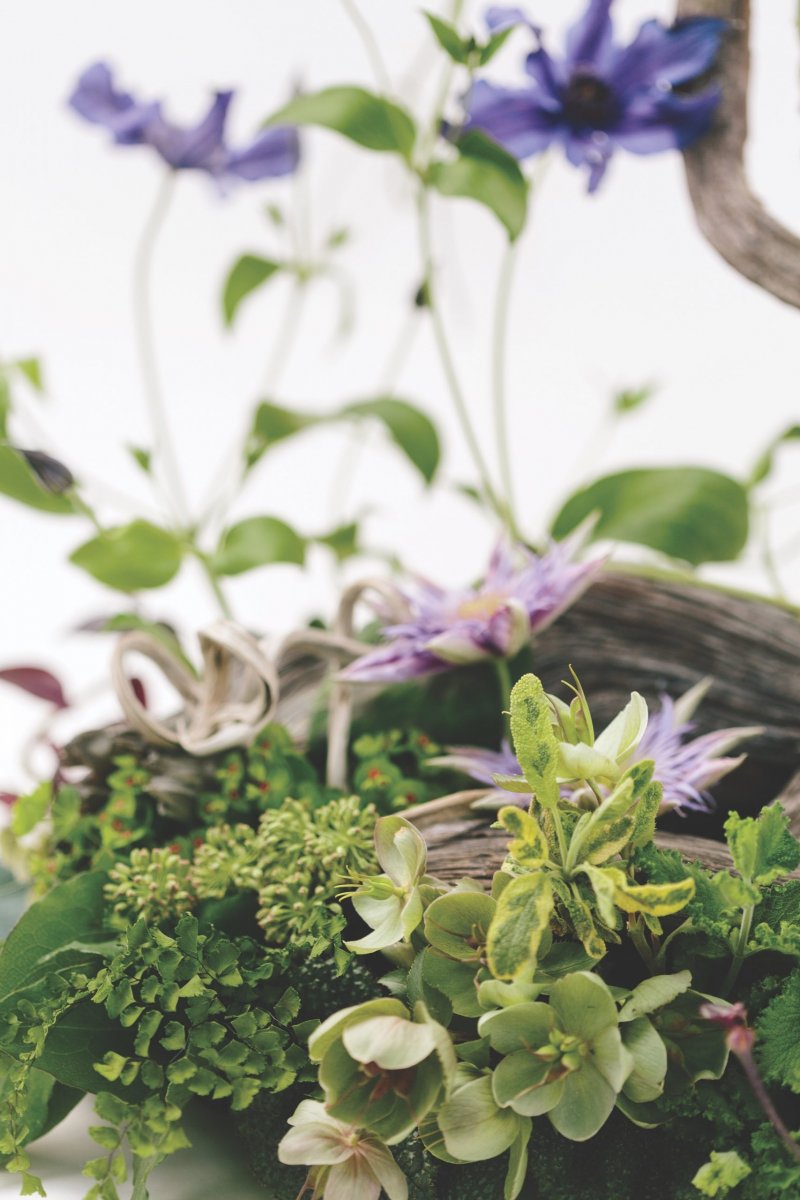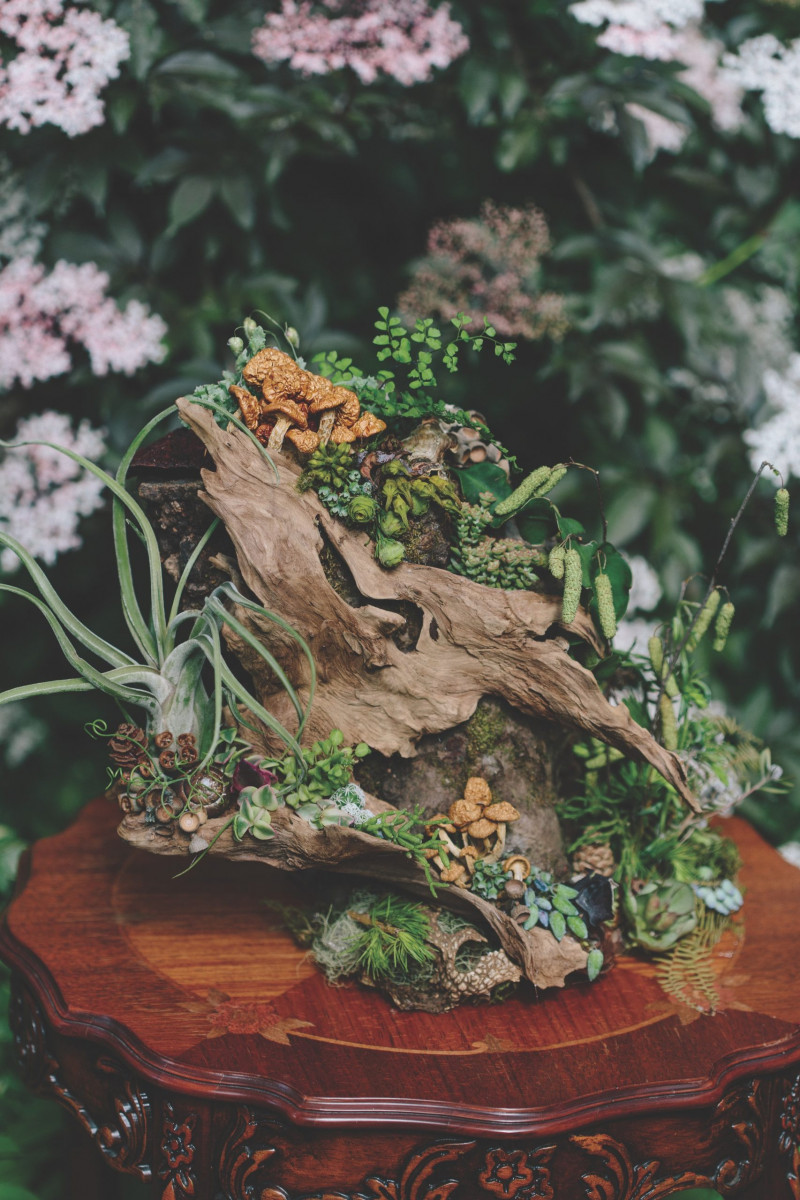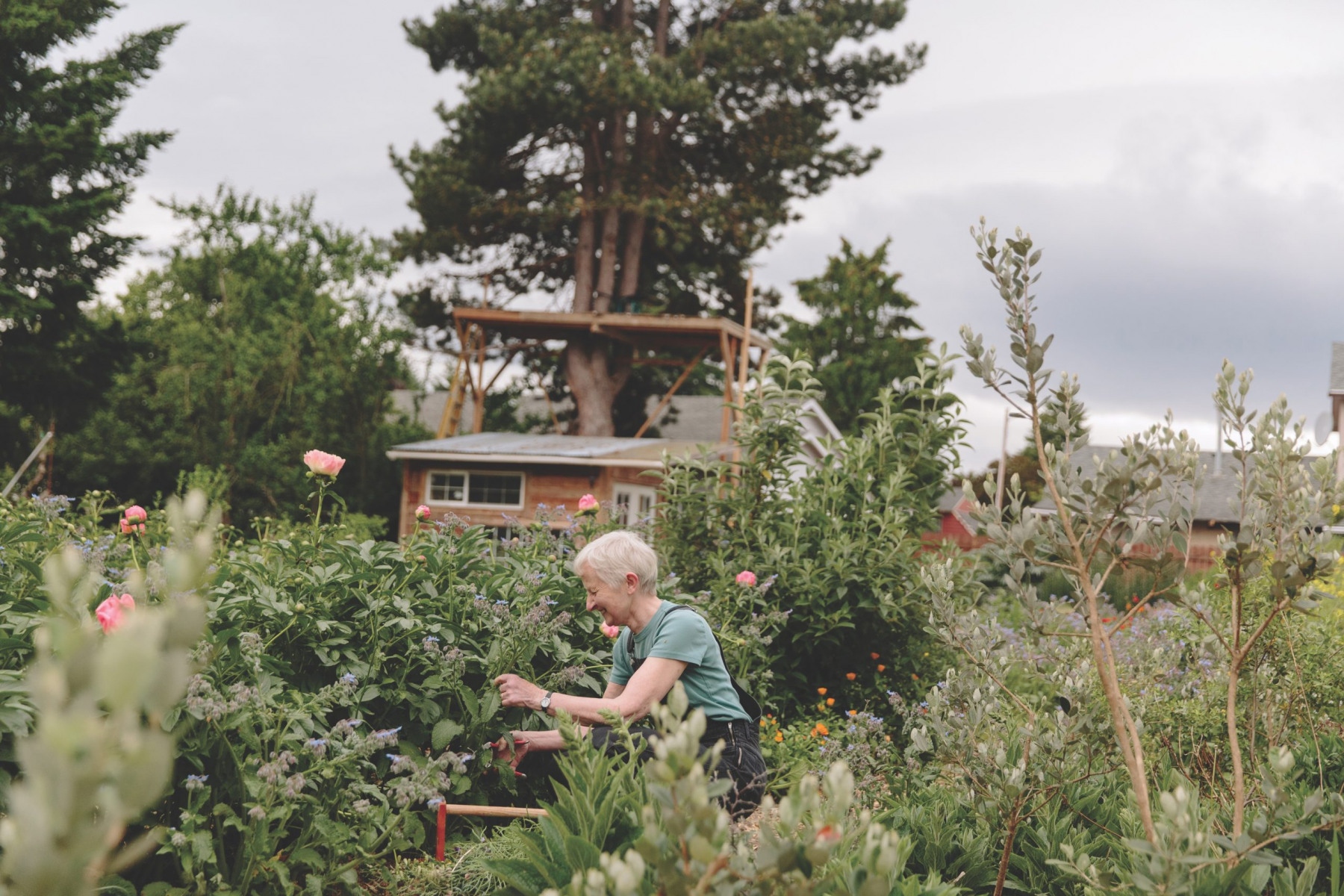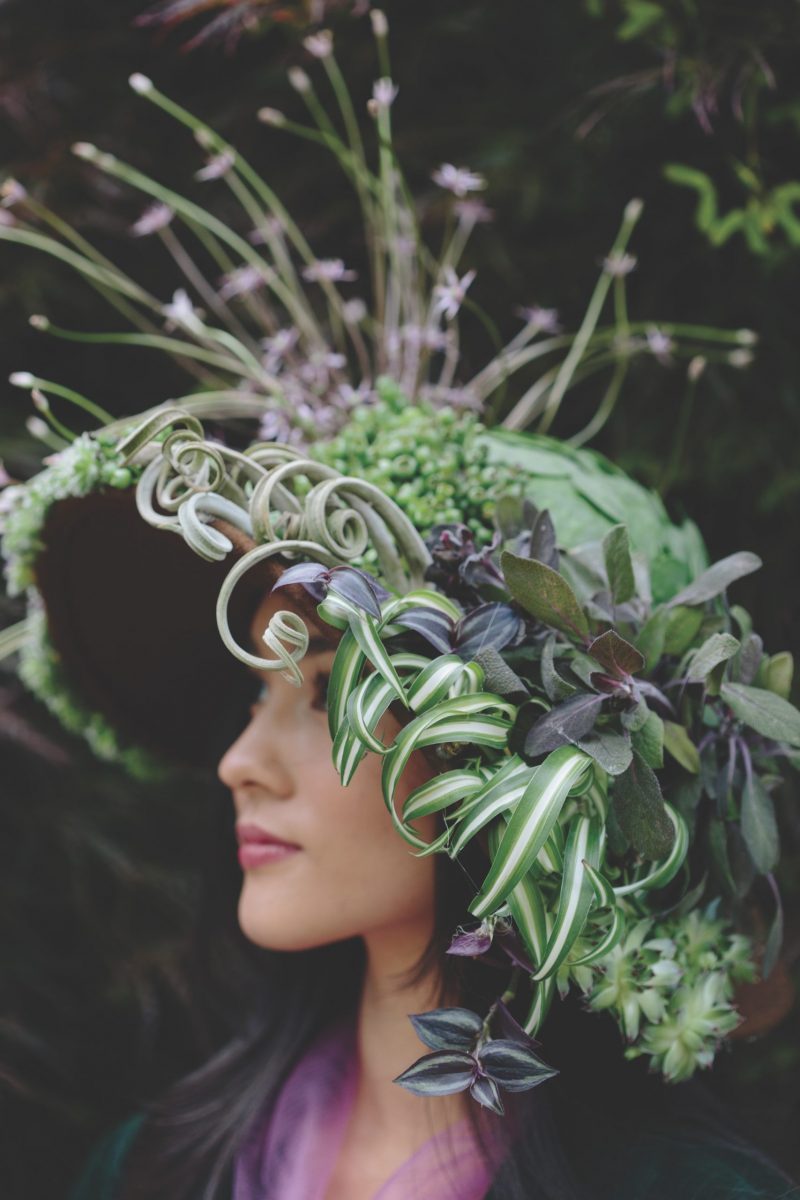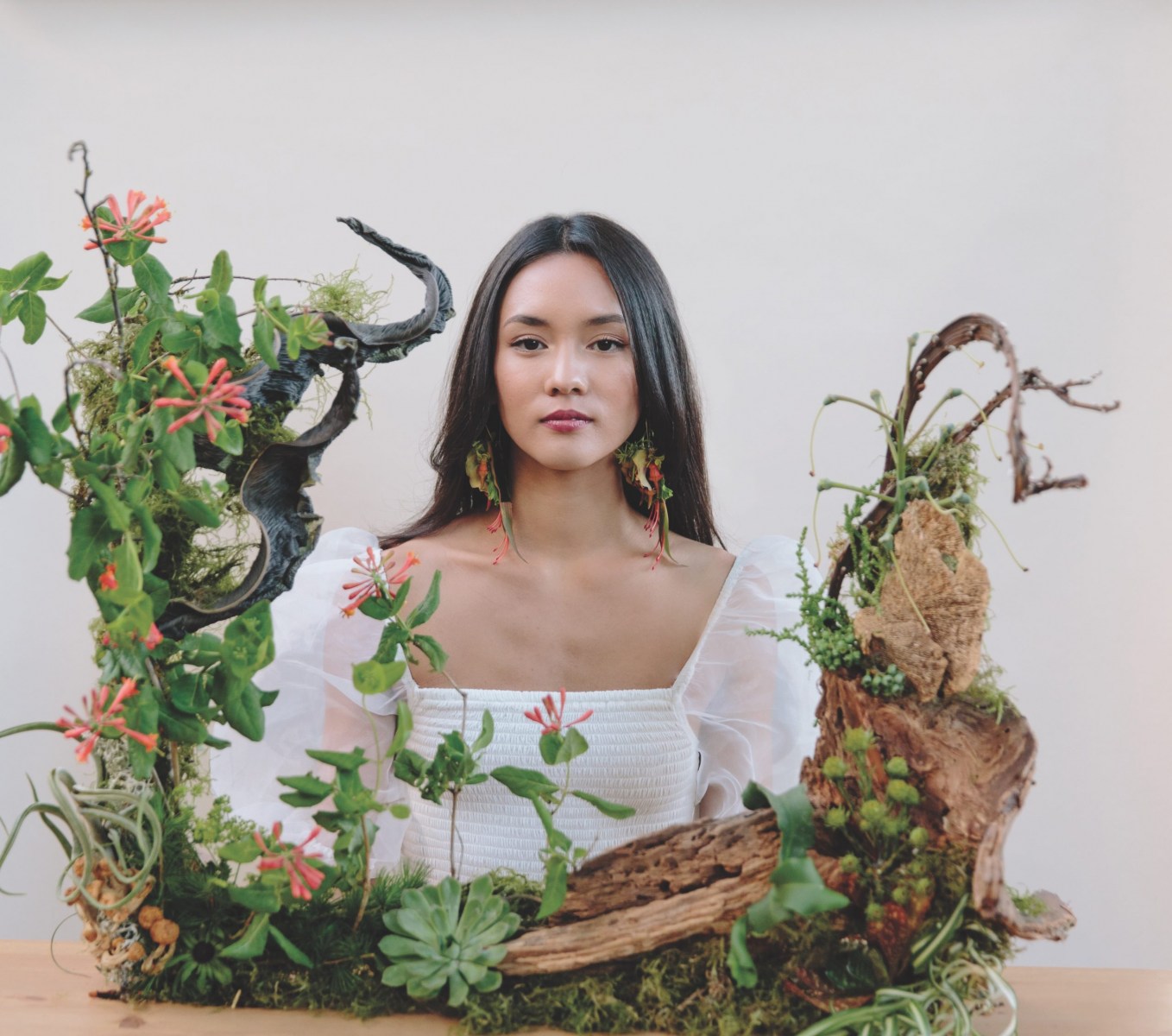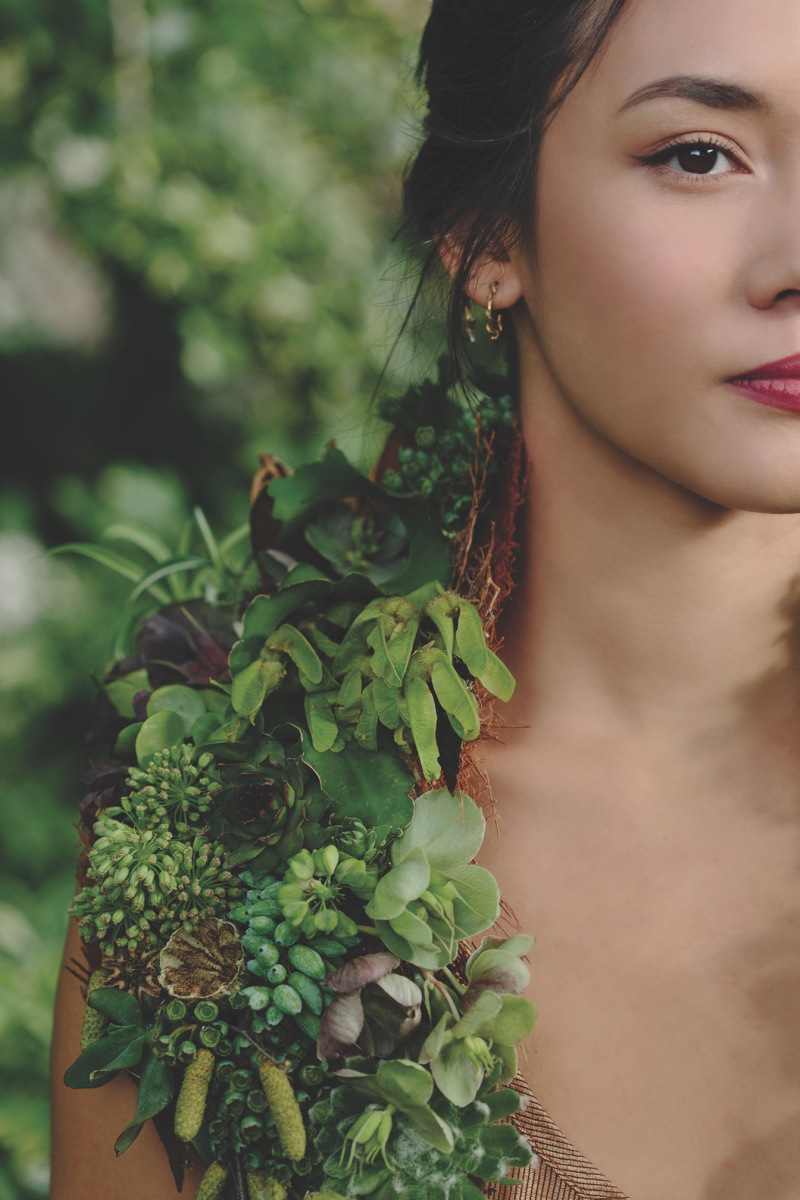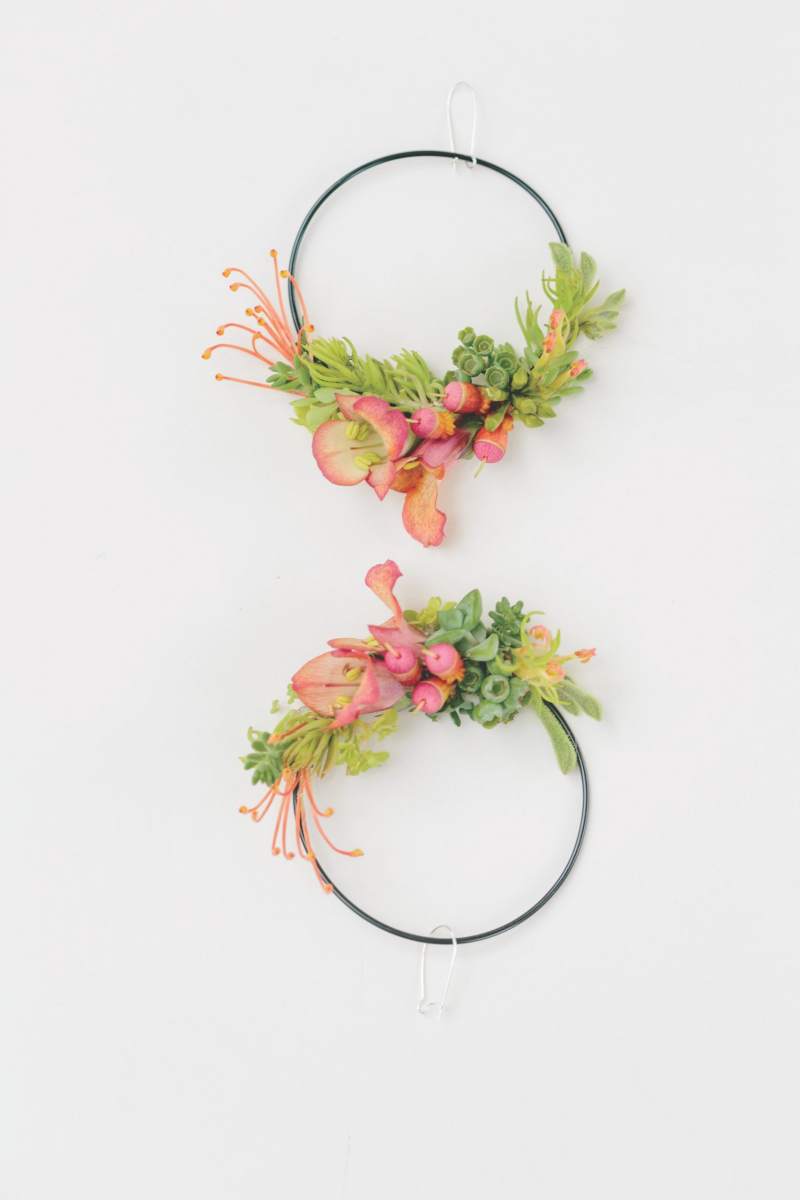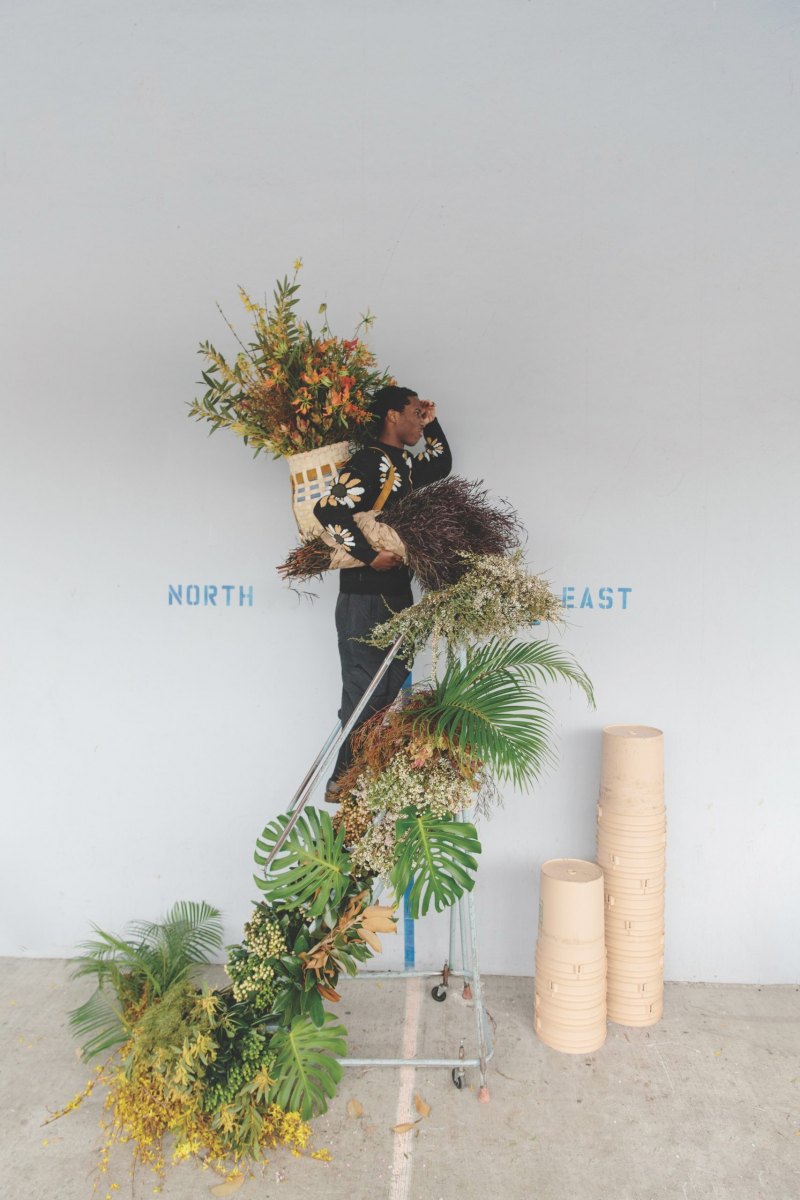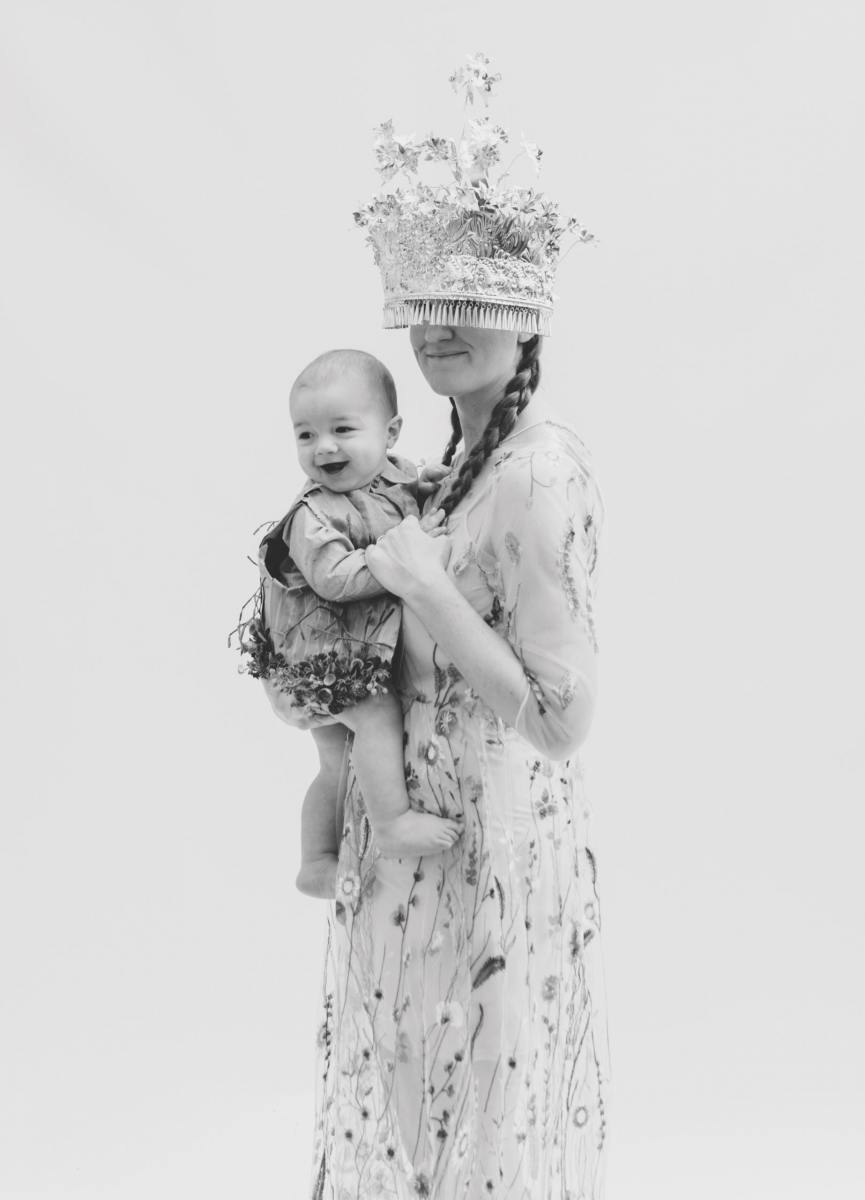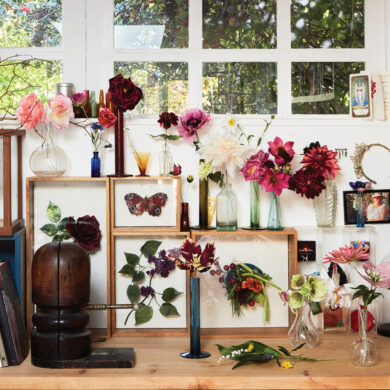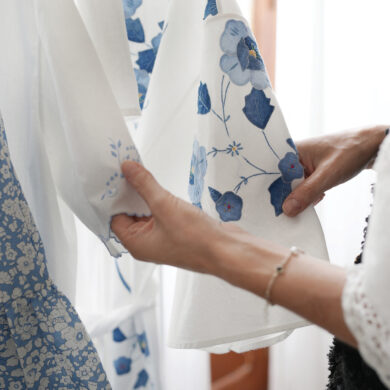Looking at Botanicals through Different Eyes
In 1996 I started my flower business in the basement, focusing on weddings and events. When we had a lovely quaint studio built in the backyard 5 years later, an abundance of bright daylight was a definite requirement.
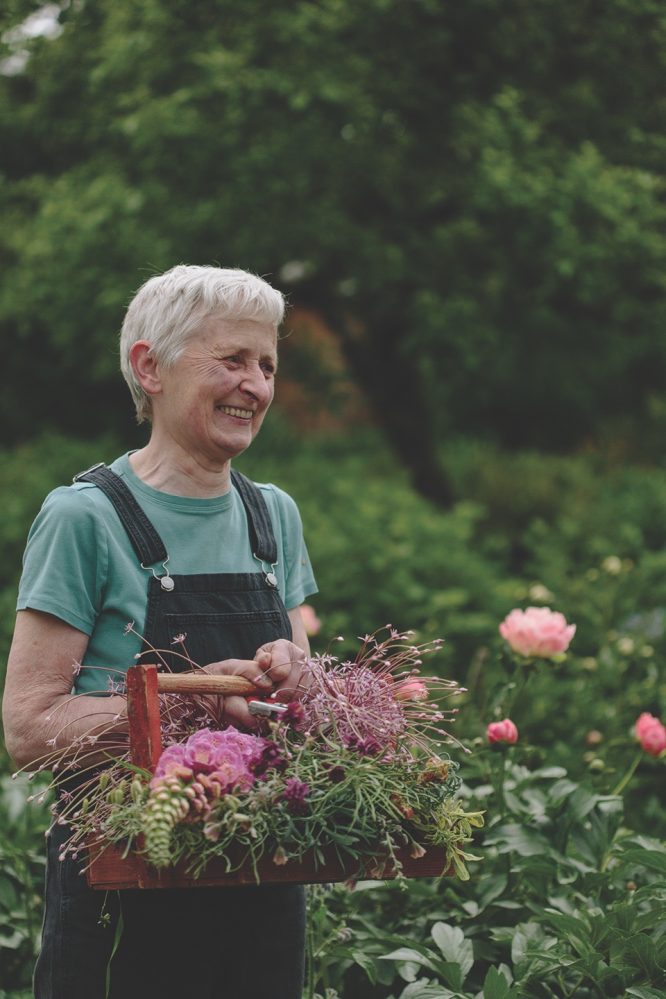
Eleven years into that business, out of nowhere, a 45-year-old memory popped in my head: my parents were avid nature lovers and when I was a kid, we spent many summer vacations in Switzerland, hiking in the Alps for a month. After lunch, my siblings and I often would gather a piece of bark, cover it with some moss, arrange a selection of wildflowers on it and give that little treasure from nature to my mom.
A friend encouraged me to emulate that idea for a photo shoot. It was the first design of what I would later call “woodland style”. A rugged piece of wood or bark—or a structure made with several pieces—becomes a container and part of the design made primarily with various natural textures. I define these other textures as any botanical materials except flowers: herbs, an extensive selection of seedpods, interesting foliage from the garden or house plants, berries, bark, branches, grasses, succulents, tillandsia, lichens, mosses, fungi, hops, green cherry tomatoes, leaves of kale…
I became somewhat obsessed with this style of design, and curiosity drove me to explore it extensively. I like to say that designing woodlands gave me new eyes. I started to look at everything in the garden and in nature from a different perspective, seeing so much beauty in overlooked gifts of Mother Nature. Gone were the days where I focused on stunning flowers only. I paid a lot more attention to the exquisite foliage of annuals, perennials, herbs, ground-covers, vines, etc., and started to incorporate them into designs. Checking for interesting seedpods of any plant became a new focus. It seemed like I never could get enough of poppy pods, eucalyptus, and nigella pods and so many more. Sometimes I would cut them in half to expose the center of the pod, brimming with tiny seeds.
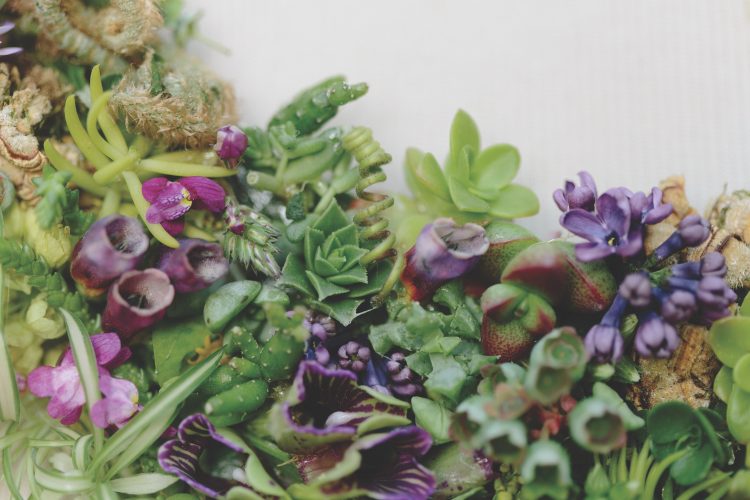
Occasionally the beauty in the bud of plants would catch my eye, and I would forego letting it bloom to use it as a newly found treasure. In the driveway, I replaced a long strip of variegated groundcover with an extensive selection of fast-growing sedums (a perfect element to make botanical jewelry). Instead of pulling the fast-growing volunteer wild strawberries plants amongst all the sedums, I would harvest them when the tiny strawberries were still green, to add some whimsy to a design. When pruning trees or shrubs, I would carefully gauge how useable the pieces would be to build a structure to design with or how I could use a hollowed-out stump or a moss-covered piece of bark as a ‘container’. I would delight in the lichen-covered branches that littered the streets in the neighborhood after a windstorm, and I’d gather them. And I would memorize which trees grew where in the neighborhood, so I knew where to collect acorns and other seedpods that had dropped on the sidewalk, as well as golden ginkgo leaves and other vibrant foliage, while ambling in this area in the fall.
When grocery shopping, I also got new eyes. The crinkly kale leaves and a variety of mushrooms became part of designs, as well as the occasional long aubergine-colored beans or the Seckel pears, key limes and kumquats. The gorgeous spiral sections of Romanesco as well as baby artichoke became newfound treasures.
Needless to say, the garden could not provide all I needed; however, my buying habits at the flower market changed and morphed to primarily purchasing textures for design.
Designing Woodlands
Mother Nature is my muse, and the exquisite variety of materials is what always inspires me to design. Typically, I only have a very vague idea of what the finished piece will look like. I buy and gather and collect a great diversity of materials and always favor seasonal and locally grown product. Sometimes I have the opportunity to harvest at the wonderful local flower farm Indigo Gardens while working on a special project as I did for this photo shoot.
The way I design is totally intuitive. Typically, I use very few flowers and rely on the endless selections of textures found in nature. Well-thought-out mechanics are indispensable, however simple or complex as they may be.
I discovered quickly that moss was needed as a go-between to glue bark or any botanicals onto wood. We are fortunate in Portland to have easy access to moss—living in a wet climate does have its perks!
When securing larger pieces of wood or bark together, a drill and zip-ties are my best friends. Once I am satisfied with the wooden structure, I decorate this ‘canvas’ with an extensive selection of ephemeral gems to create ‘landscapes’ akin to the way painters use brush and paints. The Pacific Northwest provides ample inspiration and material for creative botanical sculpture. Biodegradable foam or water tubes are necessary for the few flowers and delicate greens that require a water source. Most of the textures are glued on the moss with floral adhesive.
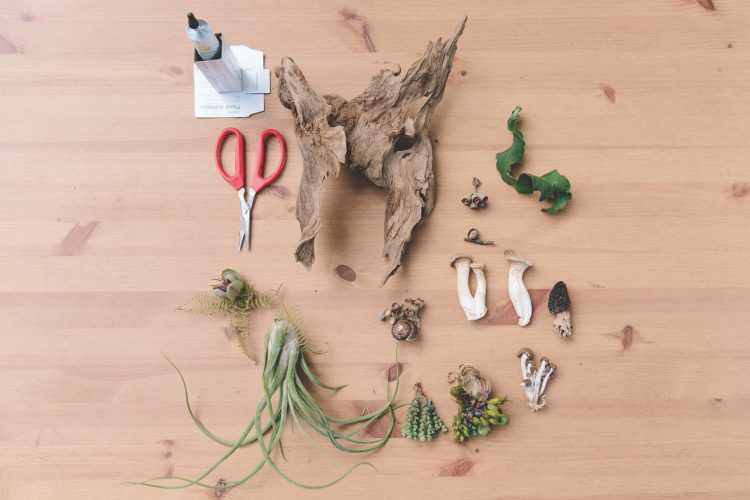
The wooden piece that will be secured to the hollowed-out stump, a selection of the textures and the tools used: floral adhesive (cold glue), scissors, and water tubes.
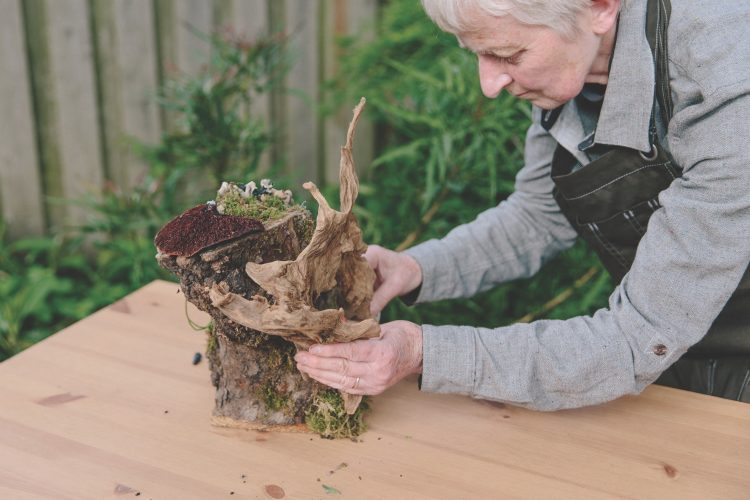
Figuring out where the wooden piece will be glued to the hollowed-out stump.
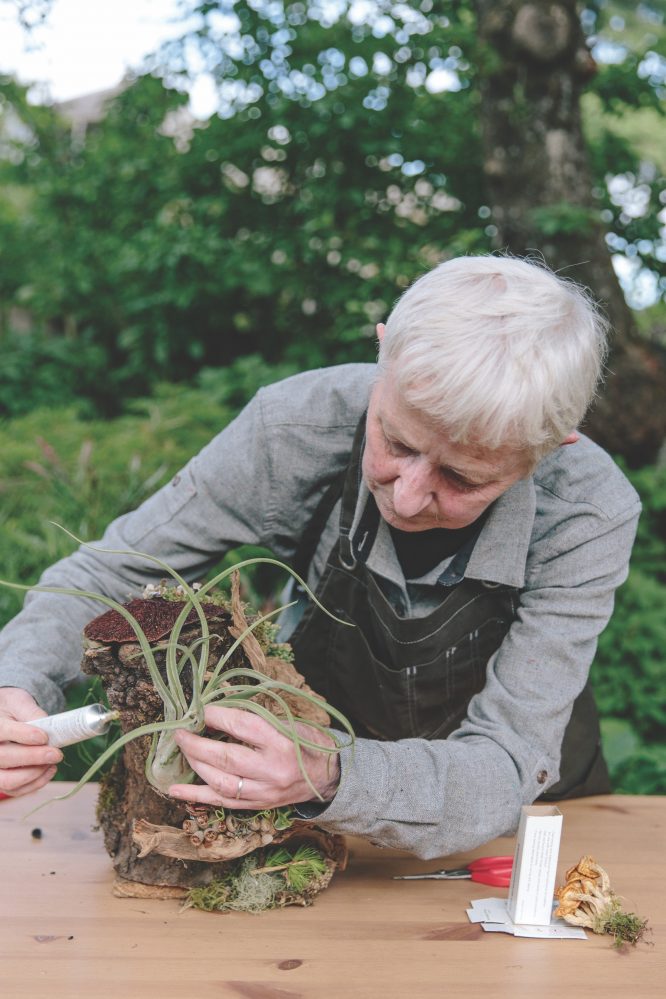
Gluing on the larger tillandsia.
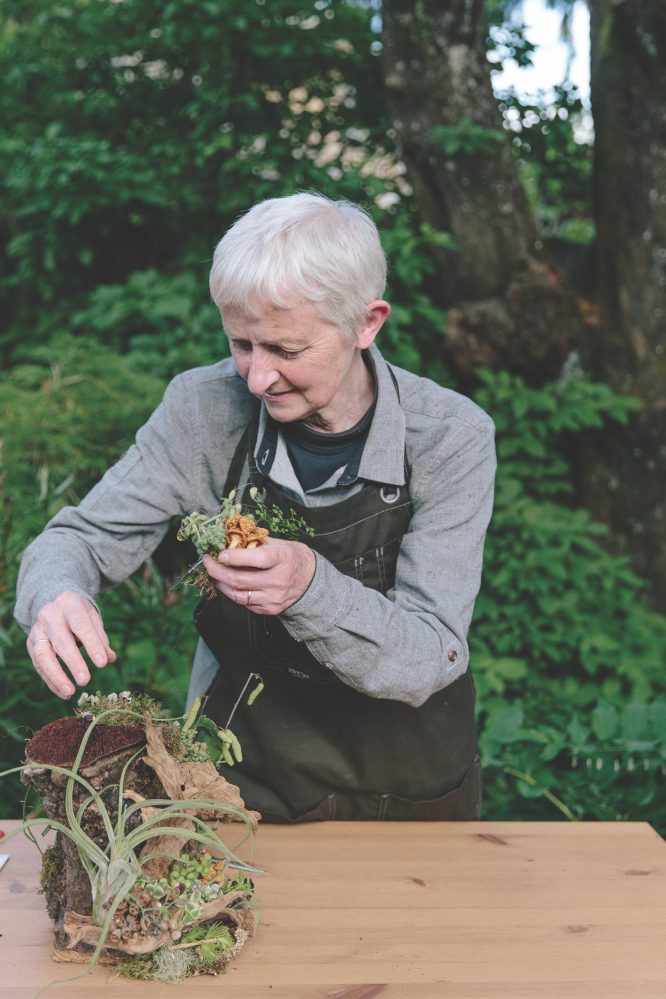
Finding the right spot for all the snippets of textures: mushrooms, succulents, seedpods, grasses, etc. …
“If a man has two pennies, he should buy a loaf of bread with one, which will sustain his life—and a flower with the other, which will give him a reason to live.” – Chinese Proverb
Designing Botanical Couture
Fashion has long been inspired by nature. Curiosity and perseverance are what led me to start exploring botanical couture 13 years ago. Considering that I never had paid attention to fashion, it is a bit humorous that as the years went by, I became so focused and passionate about designing botanical wearables. I don’t own a purse, never have worn high heel shoes nor fancy hats, and have no interest in jewelry. But when flowers came into play, I became fascinated with this type of design.
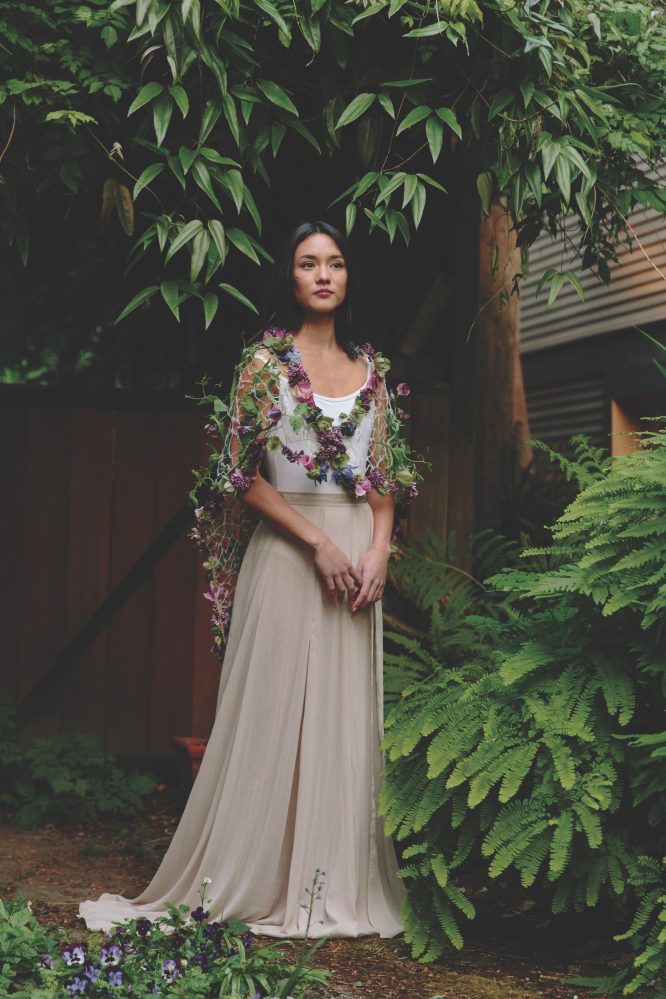
It has been a fun and interesting journey with endless potential. Botanical couture has been popular for a long time in Europe, and I have so often been inspired by the beauty that so many brilliant designers created. And the same question kept coming up: what are the mechanics behind this? Endless trial and error helped me figure out mechanics as well as which materials were best suited to create the base of jewelry, headpieces, purses, and other accessories, as well as wearables—scarves, dresses, etc.—considering that there is no water source available in these designs.
Flexible aluminum wire, aluminum mesh, and floral adhesive are the simple tools that I use to design everything. I bend, twist, and shape them until I am satisfied with the result. Sometimes I also create flexible ‘fabric’ with hot glue, as seen in the pictures of the cape.
Deconstructing flowers and textures led me to explore so many new possibilities to make jewelry and other accessories. As I love delicate details so much, these rings, earrings, and even necklaces were the perfect platform to design with snippets of flowers and plants. The last couple of years, I often have given the designs more of a woodland twist, using very few flowers and focusing more on lots of textures (bark, mushrooms, seedpods, herbs, etc.).
Process for Making Botanical Couture Last
Because it is an ephemeral art and there is no water source, the flowers and plant materials last a very short time, just like corsages and boutonnieres. However, 3 years ago while attending a workshop taught by German designer Gregor Lersch, I learned that if you place any of the botanical couture—whether it is jewelry, a shawl, cape, purse or headpiece—in a hydration box or chamber, it will last for several days.
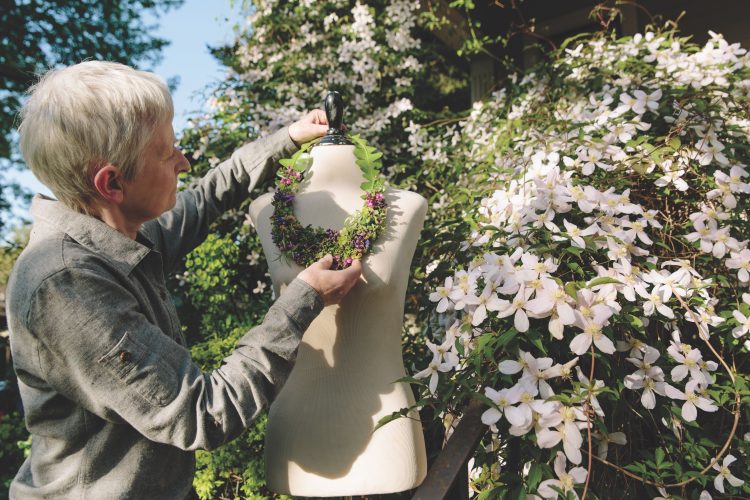
Cover any of these designs with moist paper towels and place them in a sealed box (any Tupperware or plastic storage box) in a cooler or a cool basement. It is totally fine to layer light pieces on top of one another, as long as they are separated by the moist paper towels. The flowers, petals or foliage get totally hydrated and will look fresh for several days.
So if someone would like to wear a necklace to a party on Friday and Sunday or Monday, I would make it on Thursday, and store it in a hydration box. The client would wear it to the party; when coming home, place it between moist paper towels in a sealed box in the refrigerator, and she could wear it again on Sunday or Monday evening. And of course, it’s also important to pay attention to the temperature when wearing these pieces. It’s not a good idea to wear them while standing in the sun on a 90+ degree day.
Learning about this method was a game changer for me. If I need to make many pieces for an event or a photo shoot, I can start up to 5 days ahead, and store each piece in a hydration box until the day of the event. It is a magical trick!
After working in corporate for over 20 years, I wanted to pursue what I was passionate about. Curiosity and perseverance have taken me to destinations that I never had dreamt or imagined.
When I started my flower journey, designing flowers for weddings and events in my basement, I could not possibly have imagined in my wildest dreams that it would lead to teaching workshops on woodlands and botanical couture nationwide and internationally.
I never followed trends for anything—and certainly not in floral design. It never was on my radar to travel once I started to teach. But I am very glad that I overcame the fears of taking that on, as it opened a whole new world for me. Sharing what I had learned over the years with flower enthusiasts all over the world has been beyond exciting and rewarding. And it has been an incredible opportunity to discover so many botanicals in different climate zones that I was not familiar with.
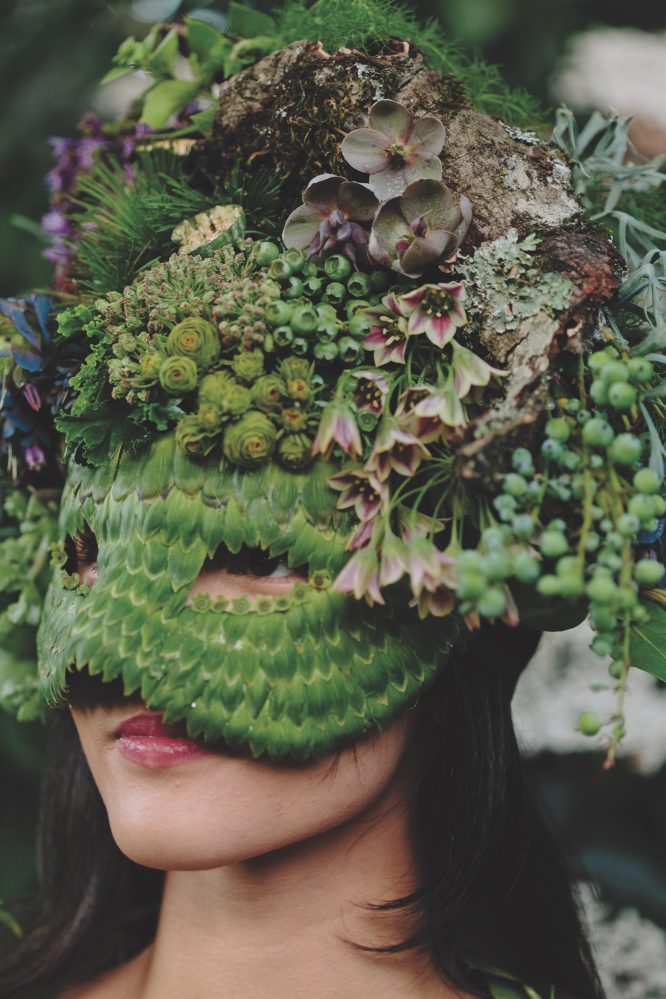
Pursuing the journey of botanical couture has also opened doors. In 2019, I was invited to participate in the magnificent flower show ‘Flower Time’. This 5-day event takes place every other year at city hall in Brussels, where every room of this magnificent 600-year-old building was decorated by 30 designers from 13 different countries. For several days, my friend Sheryl and I created elaborate woodland dresses, headpieces, and jewelry for mannequins.
The following month I had the good fortune to participate at the yearly event Fleuramour. Celebrating its 24th year, this magnificent yearly flower show took place at the spectacular 11th-century castle in Alden Biesen, Belgium. Super talented designers from over 20 different countries created brilliant installations in the many rooms of this awe-inspiring castle. Our team designed an extensive fashion show. For years I had admired this exceptional show from far away—it was the most extraordinary experience to be able to be part of it 2 years ago. Taking in all of that beauty, I couldn’t help but think back to my moss and wildflower collecting days as a young girl in Switzerland. What a gift to connect back to that innocent joy and see it come together in my life’s work.
Looking at Botanicals through Different Eyes
In 1996 I started my flower business in the basement, focusing on weddings and events. When we had a lovely quaint studio built in the backyard 5 years later, an abundance of bright daylight was a definite requirement.

Eleven years into that business, out of nowhere, a 45-year-old memory popped in my head: my parents were avid nature lovers and when I was a kid, we spent many summer vacations in Switzerland, hiking in the Alps for a month. After lunch, my siblings and I often would gather a piece of bark, cover it with some moss, arrange a selection of wildflowers on it and give that little treasure from nature to my mom.
A friend encouraged me to emulate that idea for a photo shoot. It was the first design of what I would later call “woodland style”. A rugged piece of wood or bark—or a structure made with several pieces—becomes a container and part of the design made primarily with various natural textures. I define these other textures as any botanical materials except flowers: herbs, an extensive selection of seedpods, interesting foliage from the garden or house plants, berries, bark, branches, grasses, succulents, tillandsia, lichens, mosses, fungi, hops, green cherry tomatoes, leaves of kale…
I became somewhat obsessed with this style of design, and curiosity drove me to explore it extensively. I like to say that designing woodlands gave me new eyes. I started to look at everything in the garden and in nature from a different perspective, seeing so much beauty in overlooked gifts of Mother Nature. Gone were the days where I focused on stunning flowers only. I paid a lot more attention to the exquisite foliage of annuals, perennials, herbs, ground-covers, vines, etc., and started to incorporate them into designs. Checking for interesting seedpods of any plant became a new focus. It seemed like I never could get enough of poppy pods, eucalyptus, and nigella pods and so many more. Sometimes I would cut them in half to expose the center of the pod, brimming with tiny seeds.

Occasionally the beauty in the bud of plants would catch my eye, and I would forego letting it bloom to use it as a newly found treasure. In the driveway, I replaced a long strip of variegated groundcover with an extensive selection of fast-growing sedums (a perfect element to make botanical jewelry). Instead of pulling the fast-growing volunteer wild strawberries plants amongst all the sedums, I would harvest them when the tiny strawberries were still green, to add some whimsy to a design. When pruning trees or shrubs, I would carefully gauge how useable the pieces would be to build a structure to design with or how I could use a hollowed-out stump or a moss-covered piece of bark as a ‘container’. I would delight in the lichen-covered branches that littered the streets in the neighborhood after a windstorm, and I’d gather them. And I would memorize which trees grew where in the neighborhood, so I knew where to collect acorns and other seedpods that had dropped on the sidewalk, as well as golden ginkgo leaves and other vibrant foliage, while ambling in this area in the fall.
When grocery shopping, I also got new eyes. The crinkly kale leaves and a variety of mushrooms became part of designs, as well as the occasional long aubergine-colored beans or the Seckel pears, key limes and kumquats. The gorgeous spiral sections of Romanesco as well as baby artichoke became newfound treasures.
Needless to say, the garden could not provide all I needed; however, my buying habits at the flower market changed and morphed to primarily purchasing textures for design.
Designing Woodlands
Mother Nature is my muse, and the exquisite variety of materials is what always inspires me to design. Typically, I only have a very vague idea of what the finished piece will look like. I buy and gather and collect a great diversity of materials and always favor seasonal and locally grown product. Sometimes I have the opportunity to harvest at the wonderful local flower farm Indigo Gardens while working on a special project as I did for this photo shoot.
The way I design is totally intuitive. Typically, I use very few flowers and rely on the endless selections of textures found in nature. Well-thought-out mechanics are indispensable, however simple or complex as they may be.
I discovered quickly that moss was needed as a go-between to glue bark or any botanicals onto wood. We are fortunate in Portland to have easy access to moss—living in a wet climate does have its perks!
When securing larger pieces of wood or bark together, a drill and zip-ties are my best friends. Once I am satisfied with the wooden structure, I decorate this ‘canvas’ with an extensive selection of ephemeral gems to create ‘landscapes’ akin to the way painters use brush and paints. The Pacific Northwest provides ample inspiration and material for creative botanical sculpture. Biodegradable foam or water tubes are necessary for the few flowers and delicate greens that require a water source. Most of the textures are glued on the moss with floral adhesive.

The wooden piece that will be secured to the hollowed-out stump, a selection of the textures and the tools used: floral adhesive (cold glue), scissors, and water tubes.

Figuring out where the wooden piece will be glued to the hollowed-out stump.

Gluing on the larger tillandsia.

Finding the right spot for all the snippets of textures: mushrooms, succulents, seedpods, grasses, etc. …
“If a man has two pennies, he should buy a loaf of bread with one, which will sustain his life—and a flower with the other, which will give him a reason to live.” – Chinese Proverb
Designing Botanical Couture
Fashion has long been inspired by nature. Curiosity and perseverance are what led me to start exploring botanical couture 13 years ago. Considering that I never had paid attention to fashion, it is a bit humorous that as the years went by, I became so focused and passionate about designing botanical wearables. I don’t own a purse, never have worn high heel shoes nor fancy hats, and have no interest in jewelry. But when flowers came into play, I became fascinated with this type of design.

It has been a fun and interesting journey with endless potential. Botanical couture has been popular for a long time in Europe, and I have so often been inspired by the beauty that so many brilliant designers created. And the same question kept coming up: what are the mechanics behind this? Endless trial and error helped me figure out mechanics as well as which materials were best suited to create the base of jewelry, headpieces, purses, and other accessories, as well as wearables—scarves, dresses, etc.—considering that there is no water source available in these designs.
Flexible aluminum wire, aluminum mesh, and floral adhesive are the simple tools that I use to design everything. I bend, twist, and shape them until I am satisfied with the result. Sometimes I also create flexible ‘fabric’ with hot glue, as seen in the pictures of the cape.
Deconstructing flowers and textures led me to explore so many new possibilities to make jewelry and other accessories. As I love delicate details so much, these rings, earrings, and even necklaces were the perfect platform to design with snippets of flowers and plants. The last couple of years, I often have given the designs more of a woodland twist, using very few flowers and focusing more on lots of textures (bark, mushrooms, seedpods, herbs, etc.).
Process for Making Botanical Couture Last
Because it is an ephemeral art and there is no water source, the flowers and plant materials last a very short time, just like corsages and boutonnieres. However, 3 years ago while attending a workshop taught by German designer Gregor Lersch, I learned that if you place any of the botanical couture—whether it is jewelry, a shawl, cape, purse or headpiece—in a hydration box or chamber, it will last for several days.

Cover any of these designs with moist paper towels and place them in a sealed box (any Tupperware or plastic storage box) in a cooler or a cool basement. It is totally fine to layer light pieces on top of one another, as long as they are separated by the moist paper towels. The flowers, petals or foliage get totally hydrated and will look fresh for several days.
So if someone would like to wear a necklace to a party on Friday and Sunday or Monday, I would make it on Thursday, and store it in a hydration box. The client would wear it to the party; when coming home, place it between moist paper towels in a sealed box in the refrigerator, and she could wear it again on Sunday or Monday evening. And of course, it’s also important to pay attention to the temperature when wearing these pieces. It’s not a good idea to wear them while standing in the sun on a 90+ degree day.
Learning about this method was a game changer for me. If I need to make many pieces for an event or a photo shoot, I can start up to 5 days ahead, and store each piece in a hydration box until the day of the event. It is a magical trick!
After working in corporate for over 20 years, I wanted to pursue what I was passionate about. Curiosity and perseverance have taken me to destinations that I never had dreamt or imagined.
When I started my flower journey, designing flowers for weddings and events in my basement, I could not possibly have imagined in my wildest dreams that it would lead to teaching workshops on woodlands and botanical couture nationwide and internationally.
I never followed trends for anything—and certainly not in floral design. It never was on my radar to travel once I started to teach. But I am very glad that I overcame the fears of taking that on, as it opened a whole new world for me. Sharing what I had learned over the years with flower enthusiasts all over the world has been beyond exciting and rewarding. And it has been an incredible opportunity to discover so many botanicals in different climate zones that I was not familiar with.

Pursuing the journey of botanical couture has also opened doors. In 2019, I was invited to participate in the magnificent flower show ‘Flower Time’. This 5-day event takes place every other year at city hall in Brussels, where every room of this magnificent 600-year-old building was decorated by 30 designers from 13 different countries. For several days, my friend Sheryl and I created elaborate woodland dresses, headpieces, and jewelry for mannequins.
The following month I had the good fortune to participate at the yearly event Fleuramour. Celebrating its 24th year, this magnificent yearly flower show took place at the spectacular 11th-century castle in Alden Biesen, Belgium. Super talented designers from over 20 different countries created brilliant installations in the many rooms of this awe-inspiring castle. Our team designed an extensive fashion show. For years I had admired this exceptional show from far away—it was the most extraordinary experience to be able to be part of it 2 years ago. Taking in all of that beauty, I couldn’t help but think back to my moss and wildflower collecting days as a young girl in Switzerland. What a gift to connect back to that innocent joy and see it come together in my life’s work.










